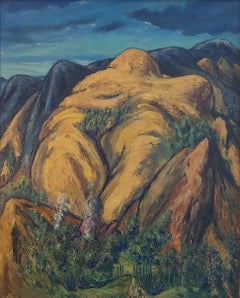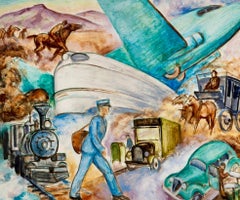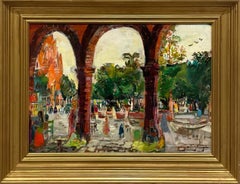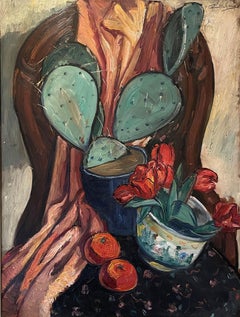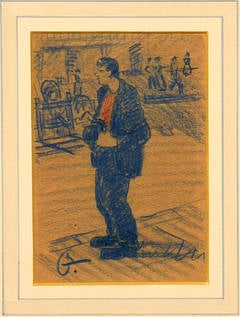Hendrik Glintenkamp Art
American, 1887-1946
The painter and illustrator Henry Glintenkamp (1887-1946) is known mainly for his anti-war illustrations that appeared in The Masses and other publications in the early twentieth century. As a painter, he was additionally successful, particularly in his landscape and urban scenes. Born in Augusta, New Jersey, the son of Hendrik and Sophie Dietz Glintenkamp, Henry received his elementary art training at the National Academy of Design (1903-06) before his study with Robert Henri the two years following.
Henri consequently attracted artists like Glintenkamp interested in returning to a sense of human qualities. Setting up his studio in the Lincoln Arcade Building with Stuart Davis and Glenn O. Coleman, Glintenkamp did work that reflects a preoccupation with urban scenes and landscapes.
In May of 1910 Glintenkamp exhibited his works as a student at the Henri School and at the Exhibition of Independent Artists of 1910. Two years later, he accepted the position of instructor at the Hoboken Arts Club in New Jersey and in 1913, he took up with others in the organization of The Masses, designed as a publication devoted to humanitarian causes. This publication stood in stark opposition to war, as its articles and cartoons reflected pacifism. At the Armory Show (1913), Glintenkamp exhibited The Village Cemetery. In 1917, Glintenkamp moved to Mexico to avoid the draft, and remained there until 1924, supporting "the socialist agenda of Mexico's new leadership."
The period following 1917 marks a new phase in the artist's development. Brighter in color and compositionally more involved, his later works are more discordant than the artist's earlier work. The artist sacrificed the atmospheric quality of the limited palette for the increased influence of modernist movements. After extensive travels in Europe, Glintenkamp returned to New York in 1934, and became a teacher at the New York School of Fine and Industrial Art and the John Reed Club School of Art. As chairman for the committee responsible for the organization of an Exhibition in Defense of World Democracy, in 1937, Glintenkamp continued his humanitarian purpose, though never really took up with the socialist rebels, many of whom followed similar groups and publications. Indeed, Glintenkamp was instrumental in founding the American Artists' Congress; he continued serving its needs as both the organization's president and secretary. A peripheral member of the impressionist-tonalist group in his early career, Glintenkamp had progressed through many American movements by the time of his death in 1946.to
1
1
1
Overall Width
to
Overall Height
to
2
1
1
2
1
1
2
2
1
1
1
1
1
1
1
1
2
9,744
2,739
1,368
1,366
1
2
Artist: Hendrik Glintenkamp
"Mexican Mountains, " Hendrik Glintenkamp, Modernist Landscape
By Hendrik Glintenkamp
Located in New York, NY
Hendrik (Henry) J Glintenkamp (1887 - 1946)
Mexican Mountains, 1940
Oil on canvas
32 x 26 inches
Signed lower left; signed and dated on the reverse
T...
Category
1940s American Modern Hendrik Glintenkamp Art
Materials
Canvas, Oil
$7,800 Sale Price
20% Off
Hendrik Glintenkamp, (Farmyard)
By Hendrik Glintenkamp
Located in New York, NY
More a wood engraving rather than a woodcut, Glintenkamp's Farmyard scene was given all the care and detail of the artist's more complex images. It is signed and numbered in pencil. ...
Category
1920s American Modern Hendrik Glintenkamp Art
Materials
Woodcut
Related Items
"History of US Postal Service" American Scene Social Realism WPA Modern Chicago
By Harold Haydon
Located in New York, NY
"History of US Postal Service" American Scene Social Realism WPA Modern Chicago
Harold Haydon
"History of the U.S. Postal Service"
21 x 25 1/2 inches
O...
Category
1930s American Modern Hendrik Glintenkamp Art
Materials
Canvas, Oil
1940s Mexican City Scene by Famed Artist Francis Chapin, San Miguel de Allende
By Francis Chapin
Located in Chicago, IL
A charming, vibrant, early Mexican city street scene by famed Chicago Modern artist Francis Chapin (Am. 1899-1965). Depicting a bustling, picturesque view of the shaded, arched arca...
Category
1940s American Modern Hendrik Glintenkamp Art
Materials
Oil, Canvas
$1,200
H 21 in W 26 in D 2 in
City at Night (Cityscape)
By Abram Tromka
Located in Wilton Manors, FL
Abram Tromka (1895-1964)
City at Night, ca. 1940.
Oil on canvas, 16 x 20 inches; 20 x 24 inches in antique oak frame. Signed lower right.
Frame is of the period, but probably not ...
Category
1930s American Modern Hendrik Glintenkamp Art
Materials
Canvas, Oil
'Hill' — American Modernism, California
By Paul Landacre
Located in Myrtle Beach, SC
Paul Landacre, 'Hill', wood engraving, 1936, edition 60 (only 54 printed); only 2 impressions printed in a second edition of 150. Signed, titled, and numbered '49/60' in pencil. Wien...
Category
1930s American Modern Hendrik Glintenkamp Art
Materials
Woodcut
A Scenic 1930s Summer Landscape Painting of Saugatuck Michigan by Francis Chapin
By Francis Chapin
Located in Chicago, IL
A vibrant, colorful summer landscape painting of Saugatuck, Michigan by notable Chicago Modern artist, Francis Chapin. Dating circa 1935, oil on canvas, the painting depicts a colorf...
Category
1930s American Modern Hendrik Glintenkamp Art
Materials
Oil, Canvas
$1,450
H 21 in W 18 in D 1.5 in
A Serene 1940's Vermont Landscape Painting by Harold Haydon
By Harold Haydon
Located in Chicago, IL
A serene 1940s Vermont Landscape, depicting evergreen trees and a lake by artist Harold Haydon. Image size: 16" x 20". Framed size: 20" x 24". In a rustic brown wood frame. Es...
Category
1940s American Modern Hendrik Glintenkamp Art
Materials
Oil, Canvas
$2,500
H 20 in W 24 in
"Flood Waters, " Landscape Wood Engraving by Harold Wescott
By Harold Wescott
Located in Milwaukee, WI
"Flood Waters" is an original wood engraving by Harold Wescott, It features a tree in the center, with its roots wrapping languidly over a form. High waters rise up from the back. Un...
Category
1930s American Modern Hendrik Glintenkamp Art
Materials
Woodcut
$1,285
H 16.37 in W 15.31 in
River Reflections
By Arthur Wesley Dow
Located in Fairlawn, OH
River Reflections
Color woodcut, c. 1910
Unsigned
Provenance: Dow Family Album, Cincinnati
Condition: Excellent
Image size: 2 1/2 x 4 inches
Sheet size: 3 1/8 x 4 7/8”
A color varian...
Category
1910s American Modern Hendrik Glintenkamp Art
Materials
Woodcut
Sunburst over the Mesas
Located in San Francisco, CA
In late spring, the high desert floor is still covered with grass and flowering yuccas. Against this colorful backdrop, the artist has captured a burst of sunlight breaking through t...
Category
1970s American Modern Hendrik Glintenkamp Art
Materials
Oil, Canvas
The Bridge
By Bror Julius Olsson Nordfeldt
Located in Santa Monica, CA
B. J. O. NORDFELDT (Bror Julius Olsson) 1878-1955)
THE BRIDGE, 1906
Color woodcut signed, dated 1906 and numbered 150 in pencil. Image 8 x 10 - small margins as issued. 4 corners tipped to acid free support board. Nordfelt is one of the most important early twentieth century American Masters of the Color woodcut. This 1906 work predates many of the other woodcut masters. Nordfeldt had a peculiar numbering system. The number is not necessarily the edition number.
Frances H. Gearhart, Blanche Lazzell, William S. Rice, Gustave Baumann, Margaret Patterson, Norma Basset Hall. Waldo Chase.
Category
Early 1900s American Modern Hendrik Glintenkamp Art
Materials
Woodcut
Tranquil Harbor (Gloucester, Massachusetts) — 1950s Cape Ann Regionalism
By Lawrence Wilbur
Located in Myrtle Beach, SC
Lawrence Nelson Wilbur (1897-1988), 'Tranquil Harbor' (Gloucester, Massachusetts), wood engraving, edition 55, 1958. Signed in pencil, and signe...
Category
1950s American Modern Hendrik Glintenkamp Art
Materials
Woodcut
$700
H 8.38 in W 10.07 in
THE THAW
By William Seltzer Rice
Located in Santa Monica, CA
WILLIAM SELTZER RICE (1873 - 1963)
THE THAW c 1915-20
Color woodcut, signed and titled in pencil. Image 8 7/8 x 12 inches, sheet 10 3/4 x 14 3/8 inches. On textured fibrous paper. V...
Category
1910s American Modern Hendrik Glintenkamp Art
Materials
Color, Woodcut
Previously Available Items
"Cactus, Tulips, and Tangerines Still Life, " Hendrik Glintenkamp, Mexico Modern
By Hendrik Glintenkamp
Located in New York, NY
Hendrik (Henry) J Glintenkamp (1887 - 1946)
Cactus, Tulips, and Tangerines Still Life, 1928
Oil on board
26 x 20 inches
Signed upper right; signed, dated and titled on the reverse
T...
Category
1920s Hendrik Glintenkamp Art
Materials
Oil, Board
Streets of New York
By Hendrik Glintenkamp
Located in Wiscasset, ME
Born in 1887 in Augusta, New Jersey, painter, printmaker, illustrator and sculptor Hendrik Glintenkamp studied at the National Academy of Design and with Robert Henri and John Sloan ...
Category
1910s Ashcan School Hendrik Glintenkamp Art
Materials
Crayon
Hendrik Glintenkamp art for sale on 1stDibs.
Find a wide variety of authentic Hendrik Glintenkamp art available for sale on 1stDibs. You can also browse by medium to find art by Hendrik Glintenkamp in oil paint, paint, board and more. Much of the original work by this artist or collective was created during the 20th century and is mostly associated with the modern style. Not every interior allows for large Hendrik Glintenkamp art, so small editions measuring 6 inches across are available. Customers who are interested in this artist might also find the work of August Mosca, Luigi Lucioni, and Frank Weston Benson. Hendrik Glintenkamp art prices can differ depending upon medium, time period and other attributes. On 1stDibs, the price for these items starts at $400 and tops out at $9,750, while the average work can sell for $6,500.
